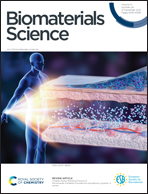Delivery of gefitinib in synergism with thymoquinone via transferrin-conjugated nanoparticle sensitizes gefitinib-resistant non-small cell lung carcinoma to control metastasis and stemness†
Abstract
Epidermal growth factor receptor (EGFR) normally over-expresses in non-small cell lung cancer (NSCLC) cells. Its mutations act as oncogenic drivers in the cellular signal transduction pathway, and induce the downstream activation of numerous key cellular events involved in cellular proliferation and survival. EGFR tyrosine kinase inhibitors (EGFR-TK inhibitors), such as gefitinib and erlotinib, have been used for a long time in the treatment of NSCLC. However, they fail to overcome the EGFR-TK mutation due to the acquisition of drug resistance. It is strongly believed that the epithelial-to-mesenchymal transition (EMT) is a key player for acquired resistance and consequent limitation of the clinical efficiency of EGFR-TKIs. Therefore, a new strategy needs to be developed to overcome the resistance in NSCLC. In this current study, we have disclosed for the first time the efficiency of transferrin-modified PLGA-thymoquinone-nanoparticles in combination with gefitinib (NP-dual-1, NP-dual-2 and NP-dual-3) towards gefitinib-resistant A549 cells. The gefitinib-resistant A549 cells (A549/GR) showed 12.3-fold more resistance to gefitinib in comparison to non-resistant A549 cells. The phenotypic alteration resembling spindle-cell shape and increased pseudopodia integuments featured the EMT phenomena in A549/GR cells. EMT in A549/GR was later coupled with the loss of Ecad and expansion of Ncad, along with upregulated vimentin expression, as compared to the control A549 cells. Moreover, the invasive nature and migration potential are more amplified in A549/GR cells. Pre-incubation of A549 cells with TGFβ1 also initiated EMT, leading to drug resistance. Conversely, treatment of A549 or A549/GR cells with NP-dual-3 effectively retrieved the sensitivity to gefitinib, restricted the EMT phenomenon, and impaired the TGFβ1-induced EMT. On unveiling the underlying mechanism of therapeutic action, we found that STAT3 and miR-21 were individually overexpressed in the A549/GR cells by transfection, and followed by treatment with NP-dual-3. Simultaneously, NP-dual-3 fragmented HIF1-α induced EMT in A549/GR cells and reduced the CSCs markers, viz., Oct-4, Sox-2, Nanog, and Aldh1. These data are self-sufficient to suggest that NP-dual-3 re-sensitizes the drug-resistant A549/GR cells to gefitinib, possibly by retrieving MET phenomena via modulation of STAT3/mir-21/Akt/PTEN/HIF1-α axis. Thus, TQ nanoparticles combined with TKI gefitinib may provide an effective platform to treat NSCLC.



 Please wait while we load your content...
Please wait while we load your content...